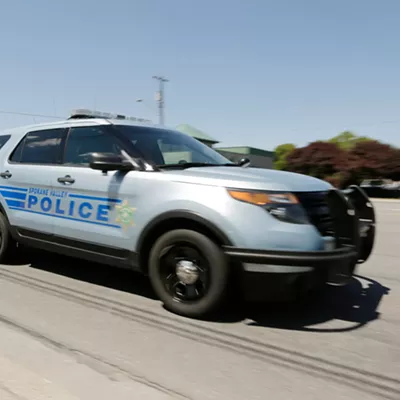The students at WSU Spokane's Interdisciplinary Design Institute kicked off the fall semester in traditional fashion last week with the seventh annual Community Design and Construction Charrette, an event that brings students from four disciplines -- architecture, landscape architecture, interior design and construction management -- together into small teams to tackle a real-world design issue. The teams have a little more than 48 hours to take in their instructions, visit the site, brainstorm ideas and produce a 30-by-40 inch presentation board that clearly communicates the design, the rationale and the budget for their plan. A jury of professionals from the community chose to honor six of the 24 teams, with members of the top team sharing a cash prize of $500.
The charrette teams last week addressed the need for a Spokane Gateway, an identifying element to greet visitors to the city entering along Division Street and to link the proposed University District with the city's central business district immediately to the west. Students had to redesign the Division corridor as "a visually coherent 'promenade' leading to some type of gateway element at the intersection of Division and Spokane Falls Boulevard." They were instructed to leave all existing structures and functions in place, while enhancing their visual attributes and amenities. Each design had to include pedestrian-friendly walkways, student housing, parking, commercial establishments and a health clinic.
Faculty and jury members are quick to point out that design competitions like the charrette do not override the usual public decision-making process, because no one of these student plans is likely to be built as currently conceived. The true value of such an exercise, they agree, lies in the variety of ideas that emerge. Ultimately, city officials may home in on features from multiple plans and refine the ideas into something that satisfies the needs of the community.
"The goal of this charrette is to contribute a voice to the larger dialogue over the future of downtown Spokane and the University District through an intensive real-world learning experience," says David Wang, associate professor of architecture and charrette coordinator.
Still, the annual charrette is far from an abstract academic exercise. Tom Reese, economic development advisor for the City of Spokane and adjunct faculty in landscape architecture, reminded the teams on Tuesday morning that design ideas generated by earlier students have influenced real bricks-and-mortar building projects across the city. In fact, this year's topic grew out of the work done last spring by students of local landscape architect and adjunct faculty member Elizabeth Payne. Those students spent half a semester developing a vision for a University District, encompassing the academic campuses of Gonzaga and Riverpoint and the East Sprague business district.
Soon after the students presented their work to Mayor John Powers and other community leaders last March, a delegation from Spokane visited the nation's capital to call on the local congressional delegation. Their presentation included the students' plans for the University District. Senator Patty Murray, who is the ranking member on the Senate Transportation Subcommittee, became excited by the vision and issued a challenge to the city.
"She said, 'Give me a funding proposal by Tuesday,' " explains Reese. "This was on a Thursday. I knew we could do it. I knew that we could work with the students over the weekend and come up with preliminary concepts that we could submit, along with our funding request."
Reese and the city got the proposal into Murray's hands on time, and the senator began shepherding the nearly $6 million request through the legislative process. If all goes well, federal money could be flowing into Spokane during the next budget year, funding the envisioned improvements along Trent, Division and East Sprague.
"I don't think we can overstate the role that WSU's design schools played for this community in this regard," Reese says. "There's such a resource here on the Riverpoint Campus, with the Interdisciplinary Design Institute and the EWU planning department. We've really been trying to formalize that relationship [between the city and the universities] and draw on that resource a lot more."
As a community judge, Reese was impressed by the students' work on the gateway project. "These are the kinds of ideas that we can now take and refine a little bit and make into real-world projects that are entirely fundable," he says. "Money follows great ideas. That's what the real potential of this process is."
Publication date: 09/04/03
















